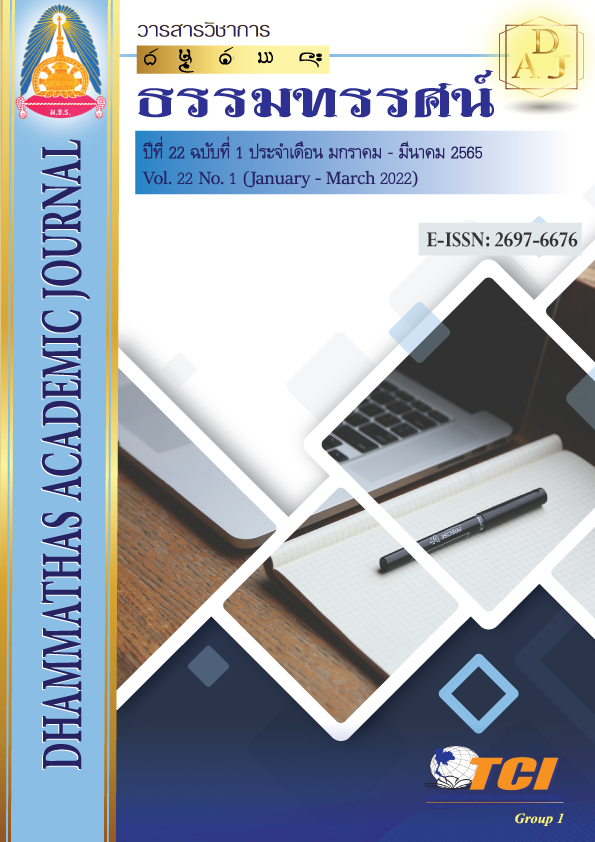Structure and process of Dhamma in the Tipitaka: Some contradictions
Main Article Content
Abstract
The objective of this research was to study the opinions of experts on the structure and process ofthe Dhamma in the Tipitaka i.e. Iddhipada, Visuddhi, Magga and Paticcasamuppada. Using the qualitative research method, the data was collected by interviewing nine key informant, qualified monks/laymen; and was analyzed by content analysis.
The results showed that: the views of the experts were divided into 4 groups: 1) agree, 2) partially agree, 3) disagree, and 4) Not sure. Overall, the experts agreed that the structure and process of Visuddhi, Magga and Paticcasamuppada supported the structure and process of individual or horizontal Iddhipada principle, and opposed the relative or vertical one. Exceptionally, the Magga principle was viewed as both supportive and opposing. Thus, the Magga has the most explanatory 8 methods, while the Visuddhi and Paticcasamuppada each has 5 and 4. It was also divided into two levels of explanation, namely Lokiya (mundane) and Lokuttara (supramundane). It showed that without the same spiritual experience, the interpretations of the Buddha’s teaching were different for sure.
Article Details

This work is licensed under a Creative Commons Attribution-NonCommercial-NoDerivatives 4.0 International License.
เพื่อให้เป็นไปตามกฎหมายลิขสิทธิ์ ผู้นิพนธ์ทุกท่านต้องลงลายมือชื่อในแบบฟอร์มใบมอบลิขสิทธิ์บทความ ให้แก่วารสารฯ พร้อมกับบทความต้นฉบับที่ได้แก้ไขครั้งสุดท้าย นอกจากนี้ ผู้นิพนธ์ทุกท่านต้องยืนยันว่าบทความ ต้นฉบับที่ส่งมาตีพิมพ์นั้น ได้ส่งมาตีพิมพ์เฉพาะในวารสาร วิชาการธรรม ทรรศน์ เพียงแห่งเดียวเท่านั้น หากมีการใช้ ภาพหรือตารางของผู้นิพนธ์อื่นที่ปรากฏในสิ่งตีพิมพ์อื่นมาแล้ว ผู้นิพนธ์ต้องขออนุญาตเจ้าของลิขสิทธิ์ก่อน พร้อมทั้ง แสดงหนังสือที่ได้รับการยินยอมต่อบรรณาธิการ ก่อนที่บทความจะได้รับการตีพิมพ์References
ปรุตน์ บุญศรีตัน. (2550). รูปแบบการตีความคัมภีร์ในพระพุทธศาสนาเถรวาท. (วิทยานิพนธ์พุทธศาสตรดุษฎีบัณฑิต). พระนครศรีอยุธยา: มหาวิทยาลัยมหาจุฬาลงกรณราชวิทยาลัย.
พระพรหมคุณาภรณ์ (ป.อ. ปยุตฺโต). (2554). พจนานุกรมพุทธศาสตร์ ฉบับประมวลธรรม. (พิมพ์ครั้งที่ 20). กรุงเทพฯ: สหธรรมิก.
_______. (2555). พุทธธรรม ฉบับปรับขยาย. (พิมพ์ครั้งที่ 32). กรุงเทพฯ: ผลิธัมม์.
มนตรี วิวาห์สุข. (2556). ศึกษาวิเคราะห์การอธิบายอิทธิบาทแบบสัมพันธ์และแบบเอกเทศ. การประชุมวิชาการระดับชาติ มหาวิทยาลัยราชภัฏนครปฐม, ครั้งที่ 5 วันที่ 18-19 กรกฎาคม 2556. นครปฐม: มหาวิทยาลัยราชภัฏนครปฐม.
_______. (2560). ความสำเร็จตามหลักอิทธิบาท. วารสารวิชาการมนุษยศาสตร์และสังคมศาสตร์ มหาวิทยาลัยบูรพา, 25(49), 13-35.
มหาวิทยาลัยมหาจุฬาลงกรณราชวิทยาลัย. (2539). พระไตรปิฎกภาษาไทย ฉบับมหาจุฬาลงกรณราชวิทยาลัย. กรุงเทพฯ: มหาจุฬาลงกรณราชวิทยาลัย.
Mallery, J., Hurwitz, R., & Duffy, G. (1986). Hermeneutics: From Textual Explication to Computer Understanding?. New York: Massachusetts Institute of Technology.
Schleiermacher, F. (1998). Hermeneutics and Criticism. In Andrew Bowie (Ed.), Cambridge Texts in the History of Philosophy. New York: Cambridge University Press.
